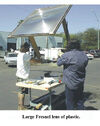Beth Ogilvie (talk | contribs) (Fixed links into new Panel Cookers page) |
|||
| Line 81: | Line 81: | ||
===Evaluation of cookers=== |
===Evaluation of cookers=== |
||
| + | Suggested criteria for evaluation: |
||
| + | '''Bold text'''Ease of use |
||
| + | This has to be the primary criterion. No matter how good a design is, if it is difficult to use it will not succeed. |
||
===Recommendations=== |
===Recommendations=== |
||
Revision as of 14:08, 30 July 2007
|
The original author of this article is Dr. Ashok Kundapur. Find more of Dr. Kundapur's work on his website: http://www.solcooker.net/Cindex.htm. |
Template:Compendium TOC
Introduction
The main purpose of this compilation is to present all possible major designs and their variations so as to prevent the solar cooker designer from wasting time on a design which has already been under the sun.
- For more details on the Compendium, see Compendium Introduction.
Concentrator Types
Concentrator cookers offer several advantages, including a mode of cooking very similar to day to day cooking. They come in many designs, classed according to whether they concentrate light from above or from below.
Cookers which concentrate light from below
Heat coming from below is most convenient for routine cooking, hence, many designers have focused on this type of cooker. There are many designs in this category, and they are classified on the basis of the type of reflectors used:
 |
Spherical reflectors Spherical mirrors are the simplest type of reflectors, very easy to build and use. |
 |
Parabolic reflectors Parabolic geometry is well known, and it was probably the very first type of solar cooker. There are many designs for parabolic cookers. The reason for its popularity is the focus, which is much better and sharper than that of other types of reflectors. At the same time it is very sensitive to even a slight change in the position of the sun and hence the use of such reflectors means constant tracking. |
 |
Fresnel reflectors Though the parabolic reflector was a perfect design, even good technicians, and even more the villagers, found it difficult to construct parabolic reflectors even with the help of templates. This is how the Fresnel reflectors gained importance. |
 |
Cylindro-parabolic cookers This design was common in water heating, but was later tried out for cooking as well, so as to cook food in more vessels. |
 |
Plane mirrors Plane mirrors, especially small pieces, yield very well to form various shapes, be it parabola, or cylindrical configurations. |
Cookers which concentrate light from above
In this type of solar cooker, the light is concentrated from above. Though this approach is not the most efficient for cooking, there are several old designs and many new designs that have used this method. One of the most interesting and popular design in this category is the CooKit created by Professor Roger Bernard of France.
 |
Lenses These cookers use one or more lenses to concentrate light instead of reflectors. |
 |
Panel cookers Simple, cheap, effective - most panel cookers are just a packet of interconnected reflectors. They unfold into a small bracket of reflectors around a central space where a cooking vessel sits in a transparent container of a heat resistant plastic. The simple cooker works well and is one of the most popular solar cookers on the planet. |
 |
Funnel cookers The funnel cooker has several advantages: it is simple to construct, and also store, and there is hardly any wastage of sheet. Supporting the funnel may pose problem in the beginning but you can easily solve the problem with, for example, a small hole in the ground to hold the base of the funnel. |
- For more details on this topic, see Concentrators from above.
Box-types
Box cookers are another group of old but popular solar cookers. The very first box cooker design was probably that of Nicholas de Saussure (1740-1799). It was simply an insulated box with glazing; this design forms the basis of all present designs of box-type cookers including Warenham’s (1995) ‘Sunstove’.
The box cookers presented here are classified on the basis of the presence or absence of reflectors, i.e., those without or with mirrors boosters.
 |
Box cookers without external reflectors One of the first cooker types designed on this planet. They are still on the scene. |
 |
Box cookers with external reflectors The Box cooker work well, but to improve the performance reflector boosters are added. Further classification of this type of cooker is based on number of reflectors. |
- For more details on this topic, see Box cookers.
Indirect Types
Indirect cookers generally use water or oil, for heating and storing energy and then use the resulting energy to cook the food. The water is heated by direct solar radiation through, for example, a cylindro-parabolic concentrator. This category includes 'chemical' cookers, biogas digesters, and solar hot water heaters, to name a few.
- For more details on this topic, see Indirect cookers.
Selecting the best design
Evaluation of cookers
Suggested criteria for evaluation: Bold textEase of use This has to be the primary criterion. No matter how good a design is, if it is difficult to use it will not succeed.
Recommendations
- See Recommendations
Conclusions
Solar cookers are here to stay, or to put it in the other way, if we have to preserve our planet then each and every one of us has to use one or the other type of solar gadget, be it a cooker, a solar water heater, or solar photovoltaic panel.
References
- See References
Other links
- See Other links
